
Isac da Silva Ferreira Lima
University of Brasilia, Brazil
Title: Factors related with early treatment for malaria in the Brazilian Amazon: A multivariable approach using a ten-year population-based malaria surveillance database
Biography
Biography: Isac da Silva Ferreira Lima
Abstract
Background & Aim: Despite all the efforts to reduce malaria incidence and to prevent deaths, the disease persists as an important public health problem in the Brazilian Amazon. Malaria is a treatable disease and essentially all deaths can be prevented throughout effective health care. Early malaria diagnostic and adequate treatment are not only a way to prevent deaths, but also an important tool for disease control in a population since it reduces the probability of mosquito bites in an infectedpatient. Consequently, the Malaria National Program (MNP) in Brazil has established as a strategic goal to decrease the delay between onset of symptoms and malaria treatment initiation. Therefore, it is important to investigate factors associated with late treatment initiation for malaria in the Brazilian Amazon to monitor the achievement of such goal. Materials & Methods: A population-based malaria surveillance database was obtained from the MNP-Ministry of Health for the period between 2004 and 2013. A multivariable adjusted logistic regression was fitted considering as outcome the lag time between onset of symptoms and treatment initiation (within 24 hours). Statistical significance was set at 0.05. Results: Over the 10-year study period, 3.3 million new cases of malaria were reportedto the MNP. Cases were mainly males (62%) and aged less than 40 years (82%). Nearly 41% of cases started malaria treatment within 24 hours of onset of symptoms. Cases receiving early treatment were at higher odds of being:i) identified in the field by active surveillance [adjusted odds ratio (AOR)=1.37; 95%CI: 1.35 - 1.39] compared to passive surveillance; aged less than 6 years(AOR=1.39; 95% CI: 1.34 - 1.44)and between 6-14 years-old (AOR=1.34; 95% CI: 1.32 - 1.36) compared to aged 30-59 years; diagnosed in 2012 (AOR=1.48; 95%CI: 1.42 - 1.54) and 2013 (AOR=1.42; 95%CI: 1.35 - 1.49) compared to cases diagnosed in 2004; from the states of Acre, Rondôniaor Roraima (AOR>1.20; p<0.05) compared to cases from the state of Pará; native population (AOR=1.43; 95% CI: 1.34 - 1.54) compared to white population; and illiterate population or with less than 4 years of formal education (AOR=1.39; 95% CI: 1.34 - 1.44) compared to population with incomplete high school or more years of education. Analysis was replicated using exclusively data from the year of 2013, and results were very similar. Conclusion: Early treatment for malaria appears to be associated with active surveillance, early ages, geographical areas and access to public health care facilities. Additionally, in recent years, cases were more likely to start treatment before 24hours since the symptoms onset. This result may indicate improvements on exam and treatment access lately in Brazil.
Speaker Presentations
Speaker PDFs
Speaker PPTs Click Here


